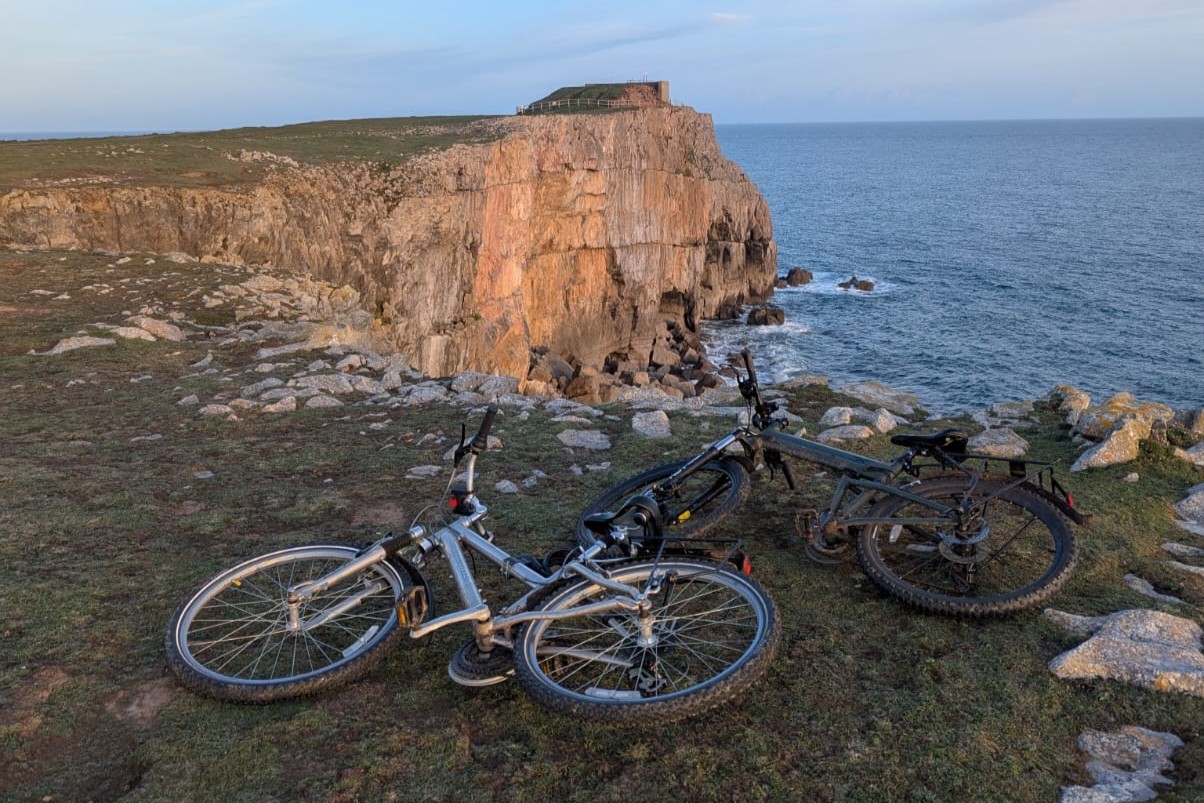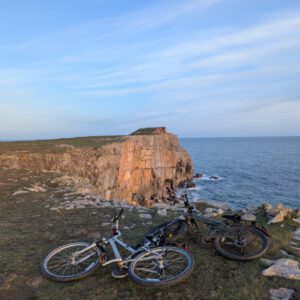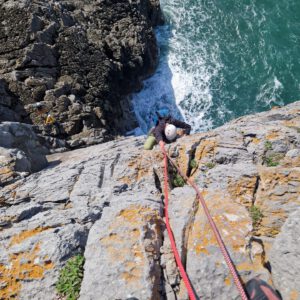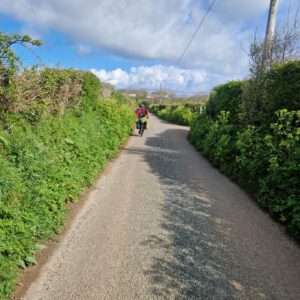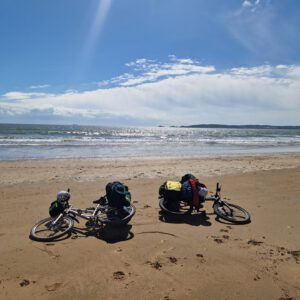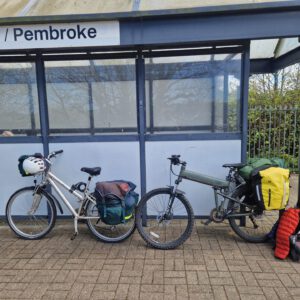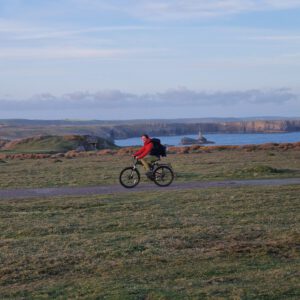Pembroke is a very popular UK climbing destination for trad climbing and while the best of it is in the Extreme grades we also found plenty of quality at a more moderate level especially around the HVS mark. Arguably the greatest appeal of Pembroke is the situation and exposure of the climbing with a mixture of walkable ledges with a cragging feel metres from the waves and committing ab-in lines that require careful awareness of the tides. It is an excellent destination for a bike trip as cycling along the coast path reduces walk-in times to practically zero and the cycle to and from the station is possible even for average cyclists with heavy gear and non-specialist bikes.
How to get there
We travelled to Pembroke town by train from our home stations, Didcot and Sheffield, then cycled for about an hour to Bosherton campsite. As is unfortunately common with UK trains we struggled with delays, cancellations and even a rail replacement bus but still got where we needed to with no significant impacts and got our train fares refunded for the hassle.
The Transport for Wales trains are fairly easy with bikes and they can be secured upright just inside the wide doors. GWR trains are less convenient as bikes are meant to be stored flipped up on one wheel on bike hooks that seem to be designed for road bikes and did not work with our slightly fatter tires. Our solution to this was unloading the bikes and storing one folded with its front wheel removed and the other wedged in the space upright which only very slightly obstructed the aisle. For bigger bikes this would be quite a challenge. On our journey out there was an issue with our train part way so it could no longer complete its journey. We instead were offered a rail replacement coach which we were able to fit our bikes in as it was not busy but I’m not sure what would have happened if it were full. On the way back we ended up with a 2 hour change in Swansea so we decided to cycle 10 minutes to the beach and conclude our trip with a quick swim!
The cycle from Pembroke town to Bosherton is about 11km with 112m of ascent which took us about an hour on heavily loaded bikes but would go much quicker for experienced cyclists. The route is mostly on quiet country roads, often single track with passing places. The direct route into and out of Pembroke town is a pretty steep hill with a fair amount of traffic and a crawler lane uphill but can be avoided on smaller roads if needed. Our bikes are somewhere between mountain bikes and tourers but you could do it on pretty much anything with only the gravel and grass along the cliff top (where most climbers walk) limiting you.
Where to stay
We camped at Bosherton Campsite which has basic facilities but is cheap and friendly. You can pitch wherever, and the farmer will come round to collect your fees in cash only. There were flushing toilets, but no loo roll provided and while it advertises a cold shower it was so close to a barn of cows you would have to stand in their excrement, and they could probably reach to lick you clean so we opted against that adventure. The campsite has two fields, we stayed in the one just beyond the village, closer to Broad Haven beach but would opt for the one closer to the village next time as it is closer to the crag and pub. The pub is St Govan’s Inn which was very useful for charging phones as the campsite had no power and offers a range of good food and drink. There are also rooms available at the pub and a couple of other campsites in the area.
How to reach the crag(s)
Most crags are accessed from the St Govan’s car park when the range is open and from there you can cycle along the clifftop directly to the top of the routes. The crags are a 5-10 minutes walk apart, less on a bike so it's easy to go between. St Govan's Head, Stennis Head and Saddle Head are three we did a few routes at and are a good place to start.
Tips
Access in Pembroke can be complicated as large areas of the climbing are in a military firing range which is only open at certain times, which can be checked here, and are clearly indicated by closed roads and red flags when inaccessible. There are some areas that are always open but need a different approach during firing and there is also the Range West area that climbers must attend a briefing to access. There are various bird bans in place to protect nests. Information on these can be found through the BMC regional access database and there are also some notices and red bollards to identify restrictions on the cliffs which are typically isolated to a few routes on some crags. Tide times are also important and many of the routes require low tide. While this all sounds intimidating there is always plenty to climb, especially if you go around school holidays when the range is typically open to the public. We found Easter to be a great time, and Autumn is ideal to avoid bird bans.
The nearest supermarket is in Pembroke town where there is a decently sized co-op and a small off-licence. There are also larger shops in Pembroke Dock slightly further away.
There are numerous beaches and nice walks you can do in the area on rest days including a large National Trust area with walking trails and a café. Deep water soloing is also an option if you don’t mind the cold!
UKClimbing.com and the RockFax app have a wealth of information on the area and can be used in place of a local guidebook if you wish. Various guidebooks are available and when we were there they had them advertised for sale at the St Govan’s Inn.
Gear: We found the rock took nuts very well and climbed with a double set of them plus a single set of cams, 10 long draws, 4 alpine draws and an assortment of slings. We used 60m half ropes but 50s would work fine. Ideally you also want an a 50m+ abseil rope, we made do with a 60m single sport rope for this, but a static line would be better and dedicated rope protectors would have been better than our makeshift one. It is generally ok to share use other’s ab ropes if they access a walkable ledge rather than a single route, but it is always best to ask first.
How to book the trip
We booked our train tickets using Trainline which allowed us to add free bike reservations, but you can also buy tickets at most stations or directly with the train service.

